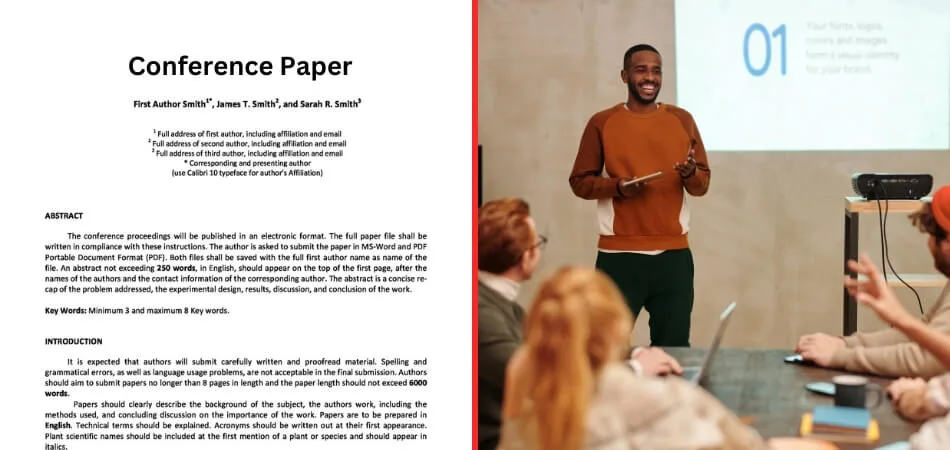In academia and professional conferences, where the exchange of knowledge and ideas is paramount, two integral elements often come into play: conference papers and presentations. But are conference papers the same as presentations?
No, conference papers and presentations are not the same. Conference papers form the basis for presentations, but they differ in format and purpose. On the other hand, presentations usually delivered at academic or professional events, are more interactive and audience-focused.
This article explores deeper into the nuances that set these two formats apart, inviting you to explore the unique characteristics and purposes of each. So join us and unravel the intricacies of conference papers and presentations.
A General Overview of Conference Paper and Presentation
Conference papers and presentations play essential roles in the field of academia and professional gatherings. Conference papers are comprehensive written documents that detail research findings, methodologies, and conclusions. They serve as the foundation for presentations, offering an in-depth exploration of the subject matter.
Presentations, on the other hand, are dynamic oral or visual communication sessions. They extract the key points from conference papers and are designed to engage the audience through visuals, discussions, and Q&A sessions. Presenters use various tools like slides, graphics, and spoken words to convey their research’s significance and relevance effectively.
While conference papers provide a thorough understanding of a topic, presentations aim to make that information accessible, engaging, and memorable for the audience. Both components complement each other in the knowledge dissemination process, ensuring that research reaches a broader audience in a meaningful and interactive manner.
Are Conference Papers the Same as Presentations?
No, conference papers are not the same as presentations. They serve different purposes within the field of academic and professional communication. While both are crucial for sharing research and insights, they take different forms and cater to varied audience needs.
Format
- Conference Papers: These are written documents, resembling research articles, providing detailed information about a study, including literature reviews, methodologies, data analysis, and conclusions.
- Presentations: These are oral or visual sessions designed for live interaction, offering summarized insights through concise slides, graphics, and spoken explanations.
Purpose
- Conference Papers: Intended for in-depth understanding, offering comprehensive data, methodology, and analysis. They contribute to the academic literature and facilitate peer review.
- Presentations: Aim to engage and inform the audience quickly, highlighting key findings and their significance. They serve as a platform for discussions and knowledge exchange.
Audience Engagement
- Conference Papers: Focus on textual comprehension, allowing readers to revisit and explore content, complete with citations and references.
- Presentations: Prioritize visual aids, verbal explanations, and audience interaction for immediate impact. They cater to various learning styles and encourage questions and discussions.
Length
- Conference Papers: Typically longer, ranging from several to dozens of pages, depending on the event’s guidelines. They provide an extensive exploration of the research.
- Presentations: Limited by time limits, usually 15-30 minutes, encouraging concise delivery of key insights and takeaways.
Interactivity
- Conference Papers: Offer limited interaction, primarily through citations, references, and the potential for follow-up discussions after the presentation.
- Presentations: Promote direct engagement through Q&A sessions, discussions, and audience participation, fostering immediate exchange of ideas.
Delivery
- Conference Papers: Issued before events, allowing for pre-event preparation, reading, and in-depth understanding. They serve as reference materials during and after the conference.
- Presentations: Delivered during conferences, ensuring real-time engagement and immediate feedback from the audience. They offer opportunities for clarifications and insights directly from the presenter.
Both conference papers and presentations play vital roles in sharing knowledge, they serve unique functions and are essential components of the academic and professional discourse.
Similarities Between Conference Papers and Presentations
In academic and professional communication, both conference papers and presentations hold crucial positions as vehicles for sharing research and knowledge. While each serves its unique purpose, they also exhibit notable similarities. Let’s explore the similarities between conference papers and presentations.
Research Foundation
Both conference papers and presentations appear from precise research, encompassing data collection, analysis, and critical evaluation. Conference papers form the research’s comprehensive foundation, whereas presentations condense this foundation into engaging sessions.
Knowledge Dissemination
Both mediums play vital roles in spreading insights and innovations beyond individual research teams. Conference papers target a global audience, contributing to academic discourse. Presentations, meanwhile, serve as dynamic platforms for sharing key findings at conferences.
Visual Aids
While conference papers primarily consist of text, they can incorporate visuals like tables and figures. Presentations, on the other hand, heavily rely on slides, images, and multimedia to enhance understanding and engagement.
Clarity and Structure
Both formats prioritize clarity and logical structure in presenting information. Conference papers organize content into sections such as introduction, methodology, results, and conclusions. Presentations follow structured formats with an introduction, key points, and conclusions.
Audience Consideration
Both mediums tailor content to suit the audience’s background and knowledge level. Conference papers provide in-depth information for researchers and experts. Presentations are designed to engage a diverse audience, accommodating varying degrees of familiarity with the subject.
Citation and Reference
Both conference papers and presentations recognize the importance of acknowledging previous research through proper citations and references. Conference papers include extensive references to related studies. Presentations may also include citations, directing the audience to additional resources for further exploration.
Pros and Cons of Using Conference Paper
Conference papers are valuable tools in the academic and professional world, but they come with their own set of advantages and disadvantages.
Pros
- In-depth Exploration: Conference papers provide ample space to delve deeply into research findings, methodologies, and analysis. Researchers can thoroughly present their work, offering comprehensive insights.
- Peer Recognition: Publishing a conference paper enhances a researcher’s credibility and visibility within their field. It signifies the acknowledgment of their work by peers and experts.
- Archival Value: Papers become part of the academic record, serving as references for future studies. They contribute to the accumulation of knowledge and facilitate the evolution of research.
- Global Reach: Conference papers can reach a wide international audience through publication and distribution. This global exposure can lead to collaborations and networking opportunities.
- Detailed Citations: Papers allow for extensive referencing and citations, acknowledging previous research contributions. This fosters an environment of scholarly integrity and builds on existing knowledge.
Cons
- Lengthy Process: Producing conference papers requires comprehensive research, writing, and revisions. Authors must invest significant effort to ensure the paper’s quality.
- Limited Presentation: The paper format may not facilitate the same level of engagement and immediate impact as oral presentations. It lacks the visual and interactive elements that presentations offer.
- Publication Costs: Some conferences may require authors to pay publication fees, impacting research budgets. These costs can be a barrier, especially for researchers with limited resources.
Pros and Cons of Presentation
Presentations are a dynamic way to share information, but they come with their own advantages and disadvantages in both academic and professional settings.
Pros
- Engagement: Presentations actively engage the audience through visual aids, verbal explanations, and interactive discussions. This interaction fosters better understanding and retention.
- Clarity: Visual elements like slides and graphics enhance comprehension and retention of complex information, making it easier for the audience to grasp key concepts.
- Time Efficiency: Presentations are concise, conveying key points quickly within a limited timeframe, making them ideal for sharing essential information efficiently.
- Feedback: Immediate audience feedback allows presenters to address questions and clarify concepts in real-time, promoting a deeper understanding of the topic.
- Networking: Presentations foster connections and discussions, leading to potential collaborations and knowledge exchange, enriching both the presenter’s and the audience’s perspectives.
Cons
- Time Constraints: Presenters must adhere to strict time limits, which may necessitate omitting valuable details. This can limit the depth of the content presented.
- Anxiety: Public speaking can induce anxiety and nervousness, affecting the presenter’s delivery and confidence. Managing this stress is crucial for effective communication.
- Superficiality: Due to time constraints, presentations may oversimplify complex topics, sacrificing depth for brevity. Presenters should strive for a balance between brevity and depth when possible.
Bottom Line
For professional advancement, conference papers and presentations serve clear but complementary roles. While conference papers offer in-depth analysis and detailed research, presentations bring this research to life through engaging and concise delivery.
Central to our discussion, are conference papers the same as presentations? lies the understanding that these two formats differ significantly in purpose and approach. Conference papers provide comprehensive insights, whereas presentations focus on engaging and summarizing key points for a broader audience.
The importance of accuracy in both formats cannot be overstated, as errors can lead to misinformation and misinterpretation. Correcting such mistakes requires prompt and careful revision, ensuring the integrity and impact of the information shared in these crucial academic platforms.








